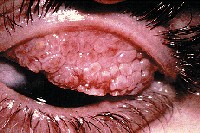1. Akpek EK, Dart JK, Watson S, et al. A randomized trial of topical cyclosporin 0.05% in topical steroid-resistant atopic keratoconjunctivitis. Ophthalmology 2004 Mar;111(3):476-82.

A: Generally, these patients have more severe allergy presentations that can produce corneal complications. Characteristic thickening of the dermis, scaling, and eczematoid lids are common. This condition is perennial, with exacerbation in the winter.
A step-up approach may not be possible since patients often present with severe symptoms and signs. Andrew Gurwood, O.D., of the Pennsylvania College of Optometry in Philadelphia, recommends:
A topical antihistamine or combination antihistamine/mast cell stabilizer to alleviate the patients symptoms. However, the mast cell stabilizing medicines are best used before the outbreak, Dr. Gurwood says.
An antibiotic may be necessary in addition to the topical steroid if this patient has large papillae causing damage to the cornea, he says.
Topical steroids remain the mainstay of treatment for atopic keratoconjunctivitis, says ophthalmologist Lawrence A. Gans, of St. Louis. Since this patient has cicatrizing changes in the conjunctiva, I would want to prevent additional conjunctival scarring from forming, so I would prescribe the topical steroid to be used four times a day, he says.

Steroids are the mainstay treatment for atopic KC, but Restasis might work, too.
As an alternative to topical steroids, prescribe an oral steroid such as prednisone or methylprednisolone until topical therapy can control the inflammation, Dr. Gans says. For the skin around the eye, he recommends the dermatologic cream Elidel (pimecrolimus 1%, Novartis). Dermatological steroid creams used on the skin to treat eczema are often irritating if they get into the eye. FML ointment, however, is not as irritating in the eye. The oral therapy will cover the eyelid skin and the conjunctiva, he says. The FML ointment is used on the eyelid margins while steroid eyedrops are used on the conjunctiva.
The newest management approach for atopic keratoconjunctivitis is a T-cell blocker, such as topical Restasis or FK-506, says ophthalmologist Eric D. Donnenfeld, of Rockville Centre, N.Y.
More than just dry eye treatment, topical Restasis (cyclosporine 0.05%, Allergan) has been proven very effective against T-cell mediated disease.1 And atopic disease is almost a pure T-cell mediated disease, Dr. Donnenfeld says. Start the patient on Restasis b.i.d.; increase the dosage to t.i.d. or q.i.d. if the patient can tolerate it, he says. Cyclosporine in oral form has also been shown to be effective in treating atopic keratoconjunctivitis.2
Topical FK-506 (tacrolimus) is another T-cell mediated disease blocker. Ophthalmologists use this dermatological cream as a very effective off-label treatment for significant eczema and skin disease around the eye, Dr. Donnenfeld says.3 Additional orals may include medications with similar action to FK-506.
Despite these encouraging new medications, recurrence of symptoms is generally the rule upon withdrawal of medications. Also, patients with atopic dermatitis should be protected from exposure to herpes simplex and vaccinia.
2. Hoang-Xuan T, Prisant O, Hannouche D, Robin H. Systemic cyclosporine A in severe atopic keratoconjunctivitis. Ophthalmology 1997 Aug;104(8):1300-5.
3. Rikkers SM, Holland GN, Drayton GE, et al. Topical tacrolimus treatment of atopic eyelid disease. Am J Ophthalmol 2003 Mar;135(3):297-302.

